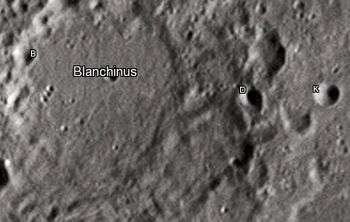Blanchinus (crater)
 Lunar Orbiter 4 image | |
| Coordinates | 25°24′S 2°30′E / 25.4°S 2.5°ECoordinates: 25°24′S 2°30′E / 25.4°S 2.5°E |
|---|---|
| Diameter | 58 × 68 km |
| Depth | 4.2 km |
| Colongitude | 358° at sunrise |
| Eponym | Giovanni Bianchini |
Blanchinus is a lunar impact crater that is situated in the rugged south-central highlands of the Moon. Adjacent to the south of Blanchinus is the crater Werner, and La Caille is attached to the northwest rim. West of the crater is the prominent formation Purbach and on the other side to the east is the smaller Krusenstern.
The outer rim of Blanchinus has been significantly degraded by subsequent impacts, leaving an irregular, notched exterior ring of rugged hills and ridges. The inner floor, in contrast, is nearly flat and free of significant impacts. Only a few tiny craterlets mark the interior surface, with Blanchinus M located near the midpoint and the remainder lie near the southwest rim.
For a few hours before the first quarter, the crater's rim contributes the lunar x visual phenomenon.
Names
The crater is named after Giovanni Bianchini whose Latinized name is Blanchinus. Like many of the craters on the Moon's near side, it was named by Giovanni Riccioli, whose 1651 nomenclature system has become standardized.[1] Earlier lunar cartographers had given the feature different names: Michael van Langren's 1645 map calls it "Fromii",[2] and Johannes Hevelius grouped it with Aliacensis and Werner under the name "Mons Antilibanus", after the Antilebanon Mountains.[3]
The name owes no relation to the etymology of another crater, but called Bianchini which is named after a later Italian astronomer Francesco Bianchini and is located in the Moon's Northern Hemisphere and is located inside Montes Jura northwest of Mare Imbrium. Blanchinus does not mainly confuse another crater on the Moon named Blancanus.
Satellite craters

By convention these features are identified on lunar maps by placing the letter on the side of the crater midpoint that is closest to Blanchinus.
| Blanchinus | Latitude | Longitude | Diameter |
|---|---|---|---|
| B | 25.2° S | 1.6° E | 8 km |
| D | 25.0° S | 4.2° E | 7 km |
| K | 24.8° S | 5.1° E | 9 km |
| M | 25.2° S | 2.6° E | 5 km |
Notes
References
- Andersson, L. E.; Whitaker, E. A. (1982). NASA Catalogue of Lunar Nomenclature. NASA RP-1097.
- Blue, Jennifer (July 25, 2007). "Gazetteer of Planetary Nomenclature". USGS. Retrieved 2007-08-05.
- Bussey, B.; Spudis, P. (2004). The Clementine Atlas of the Moon. New York: Cambridge University Press. ISBN 978-0-521-81528-4.
- Cocks, Elijah E.; Cocks, Josiah C. (1995). Who's Who on the Moon: A Biographical Dictionary of Lunar Nomenclature. Tudor Publishers. ISBN 978-0-936389-27-1.
- McDowell, Jonathan (July 15, 2007). "Lunar Nomenclature". Jonathan's Space Report. Retrieved 2007-10-24.
- Menzel, D. H.; Minnaert, M.; Levin, B.; Dollfus, A.; Bell, B. (1971). "Report on Lunar Nomenclature by the Working Group of Commission 17 of the IAU". Space Science Reviews. 12 (2): 136–186. Bibcode:1971SSRv...12..136M. doi:10.1007/BF00171763.
- Moore, Patrick (2001). On the Moon. Sterling Publishing Co. ISBN 978-0-304-35469-6.
- Price, Fred W. (1988). The Moon Observer's Handbook. Cambridge University Press. ISBN 978-0-521-33500-3.
- Rükl, Antonín (1990). Atlas of the Moon. Kalmbach Books. ISBN 978-0-913135-17-4.
- Webb, Rev. T. W. (1962). Celestial Objects for Common Telescopes (6th revised ed.). Dover. ISBN 978-0-486-20917-3.
- Whitaker, Ewen A. (1999). Mapping and Naming the Moon. Cambridge University Press. ISBN 978-0-521-62248-6.
- Wlasuk, Peter T. (2000). Observing the Moon. Springer. ISBN 978-1-85233-193-1.
External links
| Wikimedia Commons has media related to Blanchinus (crater). |
Related article
- Nemiroff, Robert; Bonnell, Jerry (December 10, 2016). "The Lunar X". Astronomy Photo of the Day (APOD).
